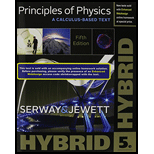
Concept explainers
(a)
The power
(a)
Answer to Problem 55P
The power
Explanation of Solution
Given Info:
The wave function for string is given as,
Formula to calculate the velocity of wave for small segment of string is,
Here,
Substitute
Assume the mass presents in the small segment
Here,
Formula to calculate the kinetic energy for small segment is,
Here,
Substitute
Integrate the equation (2) over all the string elements in the wavelength of the waves for total kinetic energy.
Formula to calculate the potential energy for string in small segment is,
Here,
Substitute
Integrate the equation (4) over all the string elements in the wavelength of the waves for total potential energy.
Formula to calculate the power
Substitute
Formula to calculate the wave length is,
Here,
Substitute
Conclusion:
Therefore, the power
(b)
The power
(b)
Answer to Problem 55P
The power
Explanation of Solution
Given Info:
The wave function for string is given as,
Formula to calculate the power for wave in the string is,
Substitute
Formula to calculate the wave length is,
Substitute
Conclusion:
Therefore, the power
(c)
The ratio of
(c)
Answer to Problem 55P
The ratio of
Explanation of Solution
Given Info:
The wave function for string is given as,
The ratio of power given as,
Substitute
Conclusion:
Therefore, the ratio of
Want to see more full solutions like this?
Chapter 13 Solutions
Principles of Physics: A Calculus-Based Text, Hybrid (with Enhanced WebAssign Printed Access Card)
- Mick and Rick are twins born on Earth in the year 2175. Rick grows up to be an Earth-bound robotics technician while Mick becomes an intergalactic astronaut. Mick leaves the Earth on his first space mission in the year 2200 and travels, according to his clock, for 10 years at a speed of 0.75c. Unfortunately, at this point in his journey, the structure of his ship undergoes mechanical breakdown and the ship explodes. How old is Rick when his brother dies?arrow_forwardHi, I have canceled, why did you charge me again?arrow_forwardNo chatgpt pls will upvotearrow_forward
 Physics for Scientists and Engineers: Foundations...PhysicsISBN:9781133939146Author:Katz, Debora M.Publisher:Cengage Learning
Physics for Scientists and Engineers: Foundations...PhysicsISBN:9781133939146Author:Katz, Debora M.Publisher:Cengage Learning University Physics Volume 1PhysicsISBN:9781938168277Author:William Moebs, Samuel J. Ling, Jeff SannyPublisher:OpenStax - Rice University
University Physics Volume 1PhysicsISBN:9781938168277Author:William Moebs, Samuel J. Ling, Jeff SannyPublisher:OpenStax - Rice University Principles of Physics: A Calculus-Based TextPhysicsISBN:9781133104261Author:Raymond A. Serway, John W. JewettPublisher:Cengage Learning
Principles of Physics: A Calculus-Based TextPhysicsISBN:9781133104261Author:Raymond A. Serway, John W. JewettPublisher:Cengage Learning Physics for Scientists and Engineers, Technology ...PhysicsISBN:9781305116399Author:Raymond A. Serway, John W. JewettPublisher:Cengage Learning
Physics for Scientists and Engineers, Technology ...PhysicsISBN:9781305116399Author:Raymond A. Serway, John W. JewettPublisher:Cengage Learning Physics for Scientists and EngineersPhysicsISBN:9781337553278Author:Raymond A. Serway, John W. JewettPublisher:Cengage Learning
Physics for Scientists and EngineersPhysicsISBN:9781337553278Author:Raymond A. Serway, John W. JewettPublisher:Cengage Learning Physics for Scientists and Engineers with Modern ...PhysicsISBN:9781337553292Author:Raymond A. Serway, John W. JewettPublisher:Cengage Learning
Physics for Scientists and Engineers with Modern ...PhysicsISBN:9781337553292Author:Raymond A. Serway, John W. JewettPublisher:Cengage Learning





